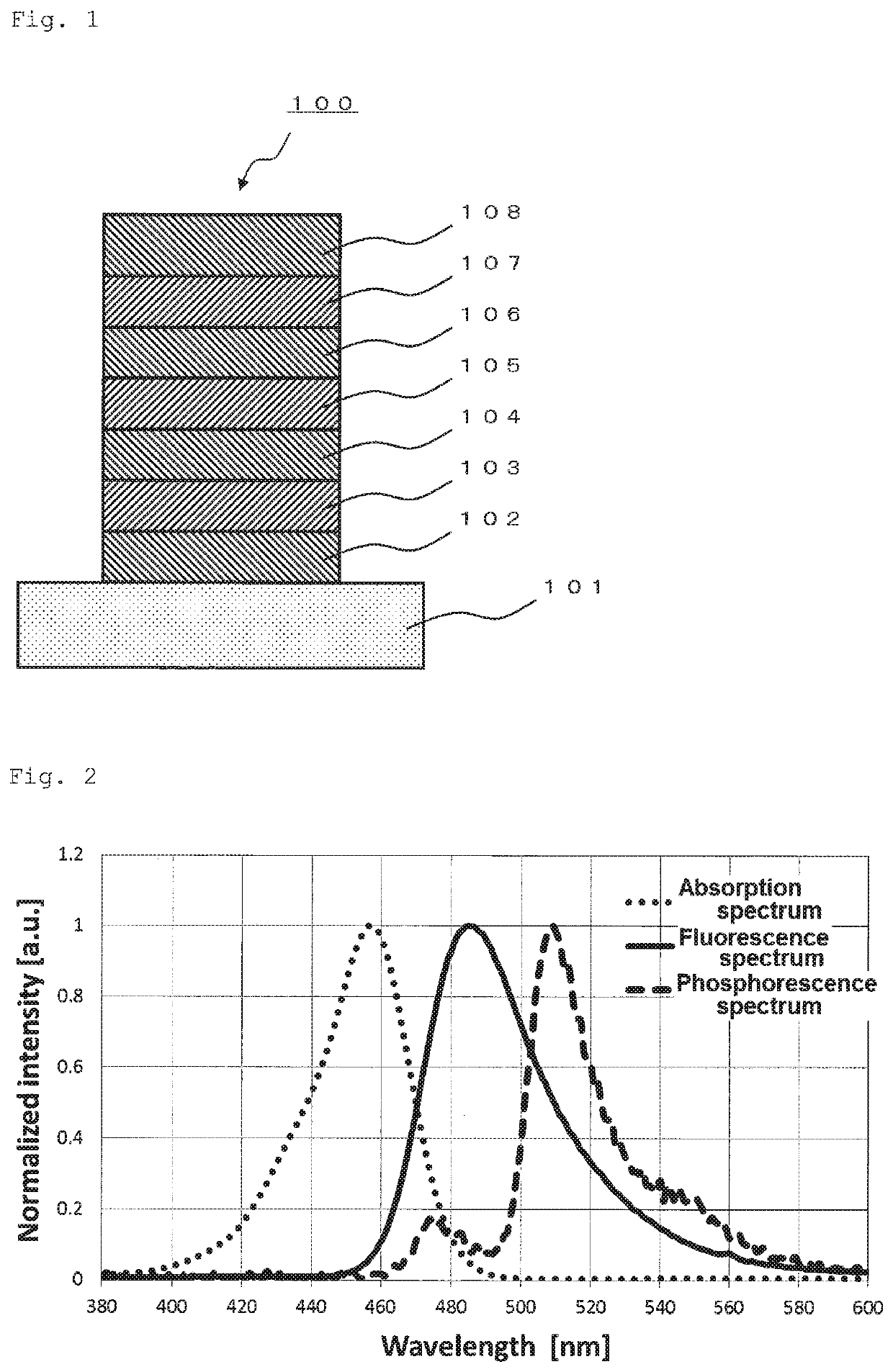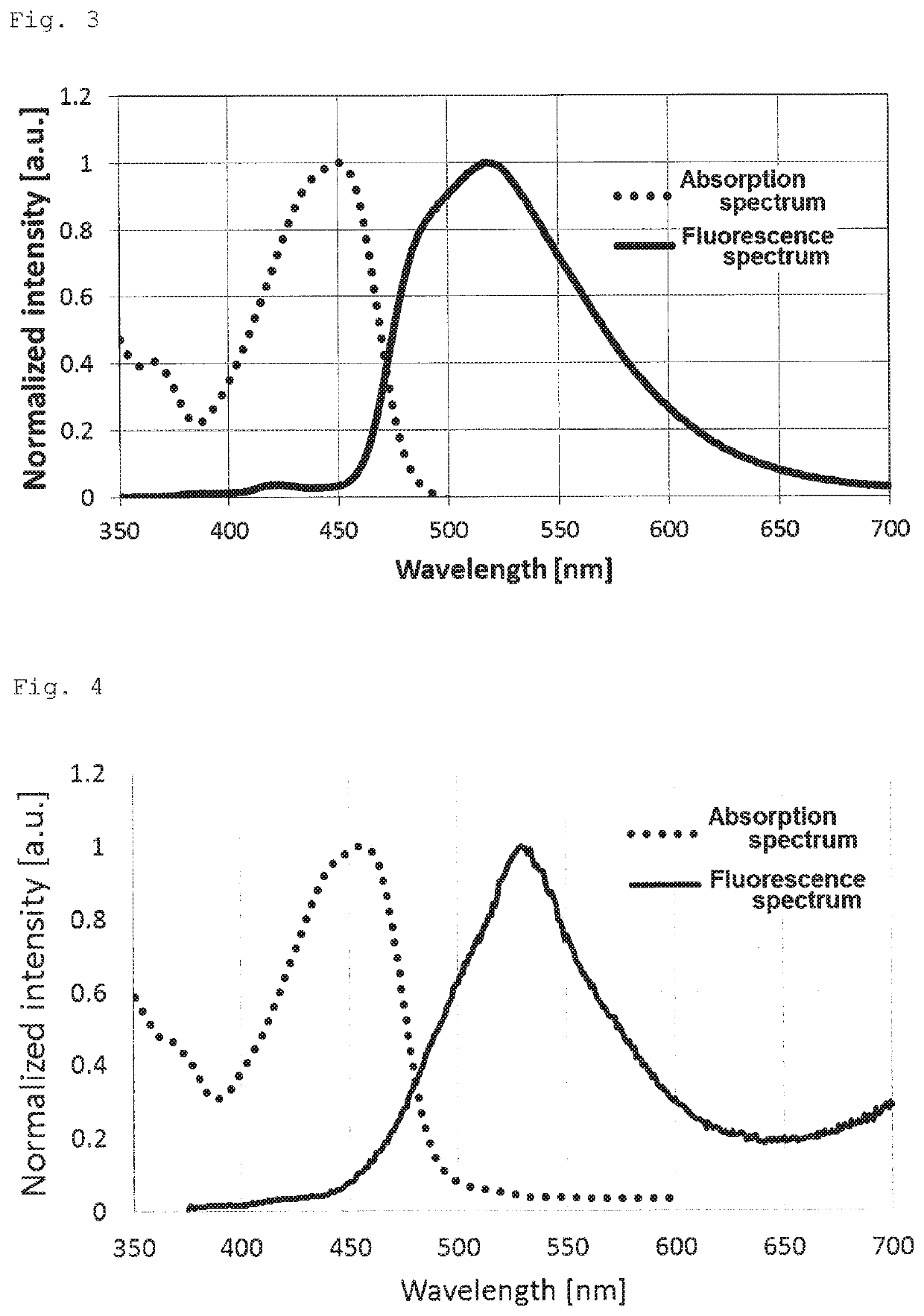Polycyclic aromatic compound
a polycyclic aromatic compound and organic electroluminescent technology, applied in the field of polycyclic aromatic compound and organic electroluminescent element, an organic field effect transistor, can solve the problems of insufficient lifetime of existing aromatic rings as host materials, insufficient redox stability of aromatic rings having small conjugated systems, and inability to describe a manufacturing method of materials other than no-linked compounds, etc., to achieve excellent organic el elements, reduce homo-luminescence gap, and high triplet ex
- Summary
- Abstract
- Description
- Claims
- Application Information
AI Technical Summary
Benefits of technology
Problems solved by technology
Method used
Image
Examples
examples
[0329]Hereinafter, the present invention will be specifically described with reference to Examples, but the present invention is not limited by these Examples in any way. Compounds synthesized in Examples are illustrated below. In the chemical structural formulas, Mes represents a mesityl group.
[0330]
Synthesis Example (1)
5,9-Bis(2,3,4,5,6-pentamethylphenyl)-3,7,11-trimethyl-5,9-dihydro-13b-aza-5,9-diboranaphtho[3,2,1-de]anthracene
[0331]
[0332]Tert-butyllithium (16 mL, 1.9 M, 30 mmol) was added to tris(2-bromo-4-methylphenyl) amine (2.62 g, 5.0 mmol) and tert-butylbenzene (20 mL) under a nitrogen atmosphere at −40° C., and the resulting mixture was stirred at room temperature for one hour. Boron tribromide (1.00 mL, 11 mmol) and tert-butylbenzene (5.0 mL) were added at 0° C., and the resulting mixture was stirred at room temperature for one hour. Thereafter, 1,2,2,6,6-pentamethylpiperidine (1.80 mL, 9.9 mmol) was added. The resulting mixture was heated at 160° C. for 15 hours. Thereaf...
synthesis example (
11)
Synthesis of 5-(diethylamino)-3,7,11-trimethyl-9-(pentan-3-yl) benzo[5,6][1,4]azaphosphino[3,2,1-de]phenophosphazinin-5,9-dioxide
[0425]
[0426]m-Chloroperbenzoic acid (m-CPBA, 138.0 mg, 77 wt %, 0.8 mmol) was added to 5-(diethylamino)-3,7,11-trimethyl-9-(pentan-3-yl) benzo[5,6][1,4]azaphosphino[3,2,1-de]phenophosphazinin-5,9-disulfide as compound (1-7-1) (54.7 mg, 0.1 mmol) and dichloromethane (7.0 mL) at −40° C., and the resulting mixture was stirred for 20 minutes. Thereafter, a saturated solution of sodium thiosulfate (5.0 mL) was added, and the resulting mixture was stirred for one hour. The organic layer was extracted with a saturated solution of sodium carbonate (5.0 mL) and dichloromethane, and the solvent was distilled off under reduced pressure to obtain a compound of formula (1-7-75) (40.0 mg, yield 78%) as a yellow solid.
[0427]
[0428]The structure of the compound thus obtained was identified with an NMR spectrum.
[0429]1H NMR (δ ppm in CD2Cl2); δ=0.71 (t, 12H), 2.32 (s, 6H...
PUM
| Property | Measurement | Unit |
|---|---|---|
| thickness | aaaaa | aaaaa |
| thickness | aaaaa | aaaaa |
| thickness | aaaaa | aaaaa |
Abstract
Description
Claims
Application Information
 Login to View More
Login to View More - R&D
- Intellectual Property
- Life Sciences
- Materials
- Tech Scout
- Unparalleled Data Quality
- Higher Quality Content
- 60% Fewer Hallucinations
Browse by: Latest US Patents, China's latest patents, Technical Efficacy Thesaurus, Application Domain, Technology Topic, Popular Technical Reports.
© 2025 PatSnap. All rights reserved.Legal|Privacy policy|Modern Slavery Act Transparency Statement|Sitemap|About US| Contact US: help@patsnap.com



